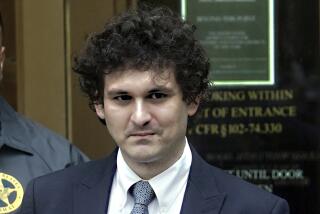Bailout redo: Back to Plan A
Meet the newest U.S. mega-bank: First National Toxic Loan.
The federal government appears to be turning back to Plan A in its efforts to bail out the financial system and get banks to lend again.
Plan A, as articulated by outgoing Treasury Secretary Henry M. Paulson in September, was to have the government buy bad loans from banks, ridding many institutions of much or most of their worst junk assets.
After Congress approved $700 billion for that program, however, Paulson shifted gears and decided to instead use the money to directly inject capital into banks.
“Here’s a boatload of taxpayers’ money. Now, lend!”
But Plan B hasn’t worked. Banks still aren’t lending -- even though they’ve sucked down $212 billion of Treasury’s funds. And counting.
Investors aren’t buying Plan B as a solution, either. An index of 24 major bank stocks has fallen every month since September and dived 29% just since year-end, to a 13-year low Friday. Confidence in the financial system remains fractured, at best.
So this week, Plan A was revived. Federal Reserve Chairman Ben S. Bernanke raised the issue Tuesday, saying in a speech that more aid for loss-racked financial companies was crucial. The government could reconsider the idea of buying bad assets for itself, he said, or it could set up “bad banks” that would make the purchases and give the selling banks equity stakes -- a way to potentially profit from a long-term workout of the assets.
On Friday, Federal Deposit Insurance Corp. Chairwoman Sheila C. Bair told the Wall Street Journal that the development of a revised Plan A was “beyond hypothetical. I think all of the agencies are committed to coming up with a program for troubled asset relief.”
Importantly, former Fed Chairman Paul A. Volcker, now an advisor to President-elect Barack Obama, has backed the idea of creating a federal entity similar to the Resolution Trust Corp., which disposed of $520 billion worth of assets from failed savings and loans from 1989 to 1996.
The central idea is that the government would have the relative luxury of engineering long-term workouts of bad loans, including mortgages.
Why might Plan A work where Plan B has failed?
First, consider the ugly saga of Bank of America Corp.
The nation’s biggest bank was considered a relatively healthy institution a year ago. Then it bought failing mortgage lender Countrywide Financial. And in September, amid the market panic that accompanied the collapse of brokerage Lehman Bros. Holdings, the bank sealed a deal to buy Merrill Lynch & Co.
Under Plan B, the Treasury pumped a total of $25 billion into the combined Bank of America/Merrill Lynch last fall.
Mission accomplished? Not hardly. Merrill’s assets were more rotten than Bank of America had assumed. By late December the bank was ready to pull the plug on the merger unless Uncle Sam opened his wallet again.
On Friday, Uncle did just that, giving the bank $20 billion more of taxpayers’ money as a capital boost, plus agreeing to swallow the vast majority of any future losses on $118 billion of the bank’s loans.
The aid package was similar to one granted to Citigroup Inc. in November.
Yet investors have taken no comfort from the enhanced bailouts of Citigroup and Bank of America. Citigroup’s shares slumped 48% this week, ending Friday at $3.50, a 16-year low. Bank of America’s shares lost 45% for the week to $7.18 on Friday, an 18-year low.
“Hard-earned taxpayer money is being blown,” said Campbell Harvey, a business professor at Duke University. Although he supported the capital-injection plan, Harvey asserted that the program should have been paired with one to get bad loans off banks’ books once and for all.
As long as so much garbage remains with the banks, there’s the risk that they’ll keep coming back for more government capital to offset loan losses, particularly if the economy worsens.
And from the standpoint of current bank shareholders, the taxpayers’ cash is becoming ever more expensive. The Obama administration has said that banks coming to the Treasury’s trough must slash their dividends.
Bank of America on Friday agreed to reduce its quarterly dividend to a mere 1 cent a share, from 32 cents.
That may be a fair trade-off for taxpayers. But if the banks are to survive in the long run as private entities -- in other words, if we aren’t intent on nationalizing them -- they’ll need fresh capital from investors who also are in the private sector. Yet under Plan B, those investors are balking at buying bank stocks, fearing that their interests will be pushed aside in favor of the government’s.
The continuing slide in bank shares shows that “investors are saying, ‘This is not a game I want to play,’ ” said David Ellison, who invests in financial stocks for fund manager Friedman, Billings, Ramsey & Co. in Alexandria, Va.
If the government were to take away some chunk of bad assets, however, it might end the vicious circle of deepening bank losses, reluctant private investors and banks’ need to ask for more U.S. help.
Of course, if creating Son of Resolution Trust Corp. was a simple matter, it already would have happened. The original RTC handled mostly buildings financed by failed S&Ls.; A new version would be charged with taking over rotten loans of banks that the government wants to survive.
What price should the banks be paid for those loans? Ten cents on the dollar? Thirty cents? Seventy cents? Offer too little and the resulting accounting write-off at the selling bank could make it insolvent. Offer too much and you slash the odds of the taxpayers profiting as the assets are worked out or resold.
Still Volcker, for one, believes Plan A is worth a shot.
In a Wall Street Journal opinion piece he co-authored in mid-September, he wrote: “The pathology of this crisis is that unless you get ahead of it and deal with it from strength, it devours the weakest link in the chain and then moves on to devour the next weakest link. . . . RTC-like mechanisms have worked well in past crises. Now is the time to take a similarly forceful step.”
--
More to Read
Sign up for Essential California
The most important California stories and recommendations in your inbox every morning.
You may occasionally receive promotional content from the Los Angeles Times.









